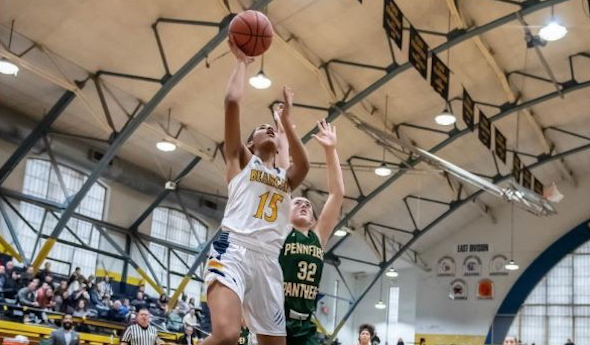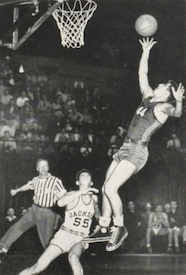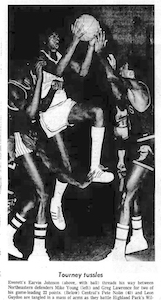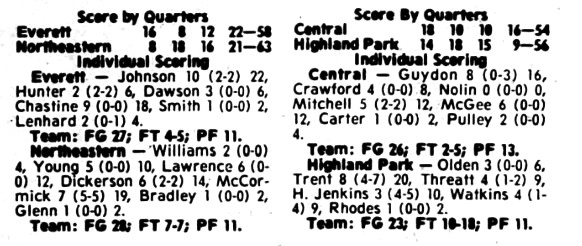
Hoops Finds Annual Home During Holidays
December 27, 2019
By Ron Pesch
Special for Second Half
Nothing says the Holidays like a high school basketball tournament.
It started, like many things do, with a drip. Well, make that a dribble.
The Michigan High School Athletic Association has allowed Holiday basketball tournaments for years. When was the first? That’s hard to establish. No one really kept track of such. A 1934 Wakefield News article indicates that a “Christmas Tournament will be held for the (Gogebic) Range teams at Wakefield December 27 and at Ironwood December 28.” Hurley, Bessemer, Ironwood and Wakefield were entered in the “blind” tournament, with opponents drawn just before game time. It was a new idea, at least in the Upper Peninsula.
“Nothing of its kind has ever been attempted in the Peninsula before,” stated the Ironwood Daily Globe. The tournament, won by Hurley, was a financial success. After expenditures, including the purchase of trophies, profit equaled enough that $22.42 was distributed to each school competing in the tournament. Plans were announced to bring back the tournament in a larger format the following year. It did return the following December, with the same teams in the same format but with all games played in Wakefield. This time out, Ironwood topped Hurley 22-21 for the tournament title.
In the Lower Peninsula in 1935, an All-Berrien County Holiday tournament was held Dec. 26, 27 and 28, with Three Oaks winning the Class B-C division title, 15-13 in the final over Berrien Springs. St. Joseph Catholic emerged as the Class D victor with a surprising 27-26 win over the reigning MHSAA state champ from Stevensville. The 14-team competition was played at Niles High School. Attendance was “slim, very slim” for the opening day of the tourney. The event did not return in 1936.
A similar, but much smaller, event was staged in Berrien County in 1941 with the Bridgman Class C Invitational. The tournament featured seven teams with contests spread over three nights. It was a success.
“Some 450 paid admissions were checked in Wednesday night for the championship finals, which Bridgman won from Berrien Springs. … The total paid admission for the three night event was 1,420 fans with a gross gate of approximately $400.”
By the mid-1940s, the idea of playing prep basketball during the Christmas lull had begun to take off across the state.
In December 1946, before a crowd of 1,500 at the Flint IMA Auditorium, Holland, the reigning Class A champion, downed Flint Northern 51-48 behind a pair of late field goals by Ken ‘Fuzz’ Bauman in the first annual Motor City Invitational. In Jackson, Detroit Catholic Central won the Michigan Catholic Invitational, beating Kalamazoo St. Augustine, 42-40. Bridgman again snagged the title at the Sixth Annual Berrien Class C Christmas Holiday Tournament. It was the Bees’ third Christmas championship in four years. The Little Eight Conference Holiday Tournament was played across four school gymnasiums as the calendar transitioned from 1946 to 1947. Bangor downed Covert, 34-29, in the championship contest hosted at Watervliet High School on Saturday, Jan. 4.
“Holiday tournament basketball has really caught on in Michigan,” said Hal Schram in the Detroit Free Press in 1947. “There will be no Christmas-New Year’s rest for at least 60 Michigan high school squads which have jumped at the chance to sharpen their collective shooting eyes for the long season ahead. … At last count, tournaments will be played between Dec 17 and Jan 3 at Flint, Saginaw, Grand Rapids, Jackson, Lincoln Park, Fremont, Negaunee, Marquette, Benton Harbor and Detroit.”
 The same eight schools that played at the first Motor City tournament – Jackson, Grand Rapids Central, Holland, Muskegon Heights, Monroe, Midland, Flint Central and Flint Northern – were invited back for the second year. According to Schram, “Not a single participating school of a year ago wanted to be left out.”
The same eight schools that played at the first Motor City tournament – Jackson, Grand Rapids Central, Holland, Muskegon Heights, Monroe, Midland, Flint Central and Flint Northern – were invited back for the second year. According to Schram, “Not a single participating school of a year ago wanted to be left out.”
Jackson downed Flint Northern in the title game, 39-34.
The Saginaw Invitational, hosted at Arthur Hill High School, boasted six Class A schools as well as Alma and Mount Pleasant, both Class B schools. Mount Pleasant surprised the field, winning the tournament with a 40-25 triumph over Dearborn Fordson in the championship game.
A year later in December, Schram wrote, “The Michigan High School Athletic Association wasn’t caught unaware when the tournament bug started to bite every sector of the state.”
“Never did we expect such a wave of tournament play as we will see during the next three weeks,” said Charles Forsythe, state director for the MHSAA, noting 34 Christmas vacation tournaments were scheduled between December 15 and January 8 during the 1948-49 basketball season. “Perhaps we’re lucky at that. The Oklahoma association has had to sanction 123 tournaments.”
Forsythe and Schram explained the reasons for the wave of popularity. Of particular interest was the fact that, at the time, a school sponsoring both football and basketball could play a total of no more than 24 games, combined, in the two sports. However, MHSAA rules allowed a basketball team the chance to play as many as three games during a Holiday tournament and be charged with only one of its allotted combination of 24 contests. (The MHSAA rules changed prior to 1972-73 to allow basketball teams a maximum of 20 games.)
Coaches could keep their squads sharp during the two-week layoff with games rather than just mandatory practices. And, as a bonus to all because tournaments were financed through gate admissions, invitations to larger tournaments meant teams got to “stay and eat at the best hostelries, go on sightseeing tours when not playing and play non-conference opponents from other sections of the state.“
Add in the chance to play before larger-than-normal crowds, and the formula for a successful tournament was cast.
Beginning with the 1950-51 season, the football-basketball rule was altered to count play in mid-season invitational tournaments as two contests. With the change, according to the Detroit Times, “the number of such meets dropped sharply.”
Only nine Holiday tournaments, involving 50-plus teams, were recorded by the MHSAA during the 1951-52 season: the 5th annual Flint Parochial Invitational, the Alpena Catholic Invitational (involving 16 teams), the 5th Annual Greater Lansing Invitational, the Albion College Invitational, the Twin-Five Conference Christmas Tournament (a 10-team replacement for the disbanded Little Eight Conference’s tournament), the Otisville Invitational, the Columbiaville Invitational and the 1st Annual Portland St. Patrick Christmas Invitational.
But by the 1960s, Holiday Tournaments were again regaining popularity, with more now focused on teams from a specific community or section of the state, especially among smaller schools.
The St. Patrick tournament was still going strong in 1966 – its 15th year – with an eight-team, four-day design. Williamston downed a Cinderella squad from Carson City, 64-44, before 1,100 fans at Portland to earn the championship. Other Mid-Michigan holiday tournaments played out in Chelsea and Swartz Creek at the same time.
The Flint Parochial League Tournament was a mainstay of the Holiday season until the breakup of the league in the early 1970s.
“Basketball tournaments have become popular around the state and nation in recent years,” wrote Wendy Foltz, longtime Battle Creek Enquirer sports editor, before the kickoff of the inaugural Battle Creek Central Holiday Cage Tournament in 1968. In a twist that harkened back to earlier days, the eight-team event represented nearly every section of lower Michigan. “Battle Creek never has been a rabid basketball town like some around the state,” added a hesitant Foltz, noting a hope that the event could at least break even.
Hosted at the Cereal City’s historic Fieldhouse, built in 1928, that first tournament was won by host Battle Creek Central, which downed Traverse City 71-53 before a crowd of 2,000. Phil Todd led the Bearcats with 29 points, including 21 in the first half, while 6-foot-8 Tom Kozelko paced TC with 24. Muskegon Heights won the consolation game, holding off a late Ypsilanti Willow Run rally, 78-77. Other schools competing were Battle Creek Lakeview, Grand Blanc, Romulus and recently-opened Jackson Lumen Christi.
Chuck Turner, Central’s head coach, and junior varsity coach Jack Schils had contacted 60 schools during the summer of 1967 to organize the 12-game schedule.
“The response was terrific,” said Schils, who added, “Many schools could not accept because of schedule commitments but want to enter a year hence.”
The Battle Creek tournament was back in 1969, again hosting teams from near and far. Schils noted that cost ran high when teams were brought in from long distances: “However, this type of tournament is highly desirable so we hope fans will support it.”

 But the event was discontinued following the 1970-71 season when the “eight team format became too unwieldy,” according to the Enquirer “… and both crowd and the quality of play declined.”
But the event was discontinued following the 1970-71 season when the “eight team format became too unwieldy,” according to the Enquirer “… and both crowd and the quality of play declined.”
Pared down to a four-team format, it returned in a big way in December 1975. The tournament saw standing-room-only crowds of more than 3,000 for games between Battle Creek Central, Detroit Northeastern, Class A quarterfinalist Lansing Everett and reigning Class A champion Highland Park.
Detroit Northeastern downed Lansing Everett, 63-58 for the Cereal City championship trophy. Everett junior Earvin Johnson scored 22 points and, with teammate Reggie Chastine, was named to the all-tournament team along with Northwestern’s Wilbert McCormick, the tourney MVP, and his teammate Greg Lawrence. Highland Park’s William Trent and Battle Creek Central’s Leon Guydon also were named to the team.
By the 1980s, it seemed that the Christmas break nearly mimicked March in Michigan.
“I think a Christmas tournament really helps your program,” said Turner in 1980 to the Enquirer. He had taken over the head coaching position at Battle Creek in the fall of 1967 after a successful stint at Willow Run. “I don’t understand basketball teams having a preseason, playing three or four games, then taking two weeks off. When you get back, it’s like starting over.”
Besides Turner’s squad, the 1980 field included Detroit Western, Detroit Murray Wright and eventual winner Kalamazoo Central. The event would ultimately be re-christened the Battle Creek Central Chuck Turner Holiday Classic.
“The late Chuck Turner started bringing big games to the city over the holidays when he first started at the school in the 1960s,” wrote Bill Broderick in the Enquirer in 2018.
“Chuck started this because he wanted to give people the chance to come back home for the holidays and see everyone play. It’s been like a family reunion over the years,” Fred Jones told Broderick. Jones was a longtime assistant to Turner. “That we can keep it going in his name is great and hopefully we can keep if going for another 50 years.”
The girls are now part of the action. All five Battle Creek city schools – Central, Pennfield, Harper Creek, Lakeview, and St. Philip – were part of the event in 2018.
This year the Chuck Turner Central Field House Holiday Classic will again span two days – December 27 and 28 – and will again see all five city schools play on the historic floor.
Other Holiday tournaments scheduled this year include:
Petoskey Invitational – December 13-14
Raider Shootout – December 21
18th Annual Muskegon Area Sports Hall of Fame Classic – December 27
Earl McKee Classic – December 27-28
North Farmington Holiday Extravaganza – December 27
Motor City Roundball Classic – December 27
Cornerstone Invitational – December 27
Washtenaw Hoops Showcase – December 28
 Ron Pesch has taken an active role in researching the history of MHSAA events since 1985 and began writing for MHSAA Finals programs in 1986, adding additional features and "flashbacks" in 1992. He inherited the title of MHSAA historian from the late Dick Kishpaugh following the 1993-94 school year, and resides in Muskegon. Contact him at [email protected] with ideas for historical articles.
Ron Pesch has taken an active role in researching the history of MHSAA events since 1985 and began writing for MHSAA Finals programs in 1986, adding additional features and "flashbacks" in 1992. He inherited the title of MHSAA historian from the late Dick Kishpaugh following the 1993-94 school year, and resides in Muskegon. Contact him at [email protected] with ideas for historical articles.
PHOTOS: (Top) The Battle Creek Central and Pennfield girls face off during the 50th Chuck Turner Classic. (Middle) Shaheen Shaheen scores two points for Flint Northern, which fell to Jackson 39-34 during the 1947 Motor City championship game. (Below left) Lansing Everett’s Earvin Johnson makes a move toward the basket against Detroit Northeastern during the 1975 Battle Creek event. (Below right) Box scores from the 1975 tournament include Johnson’s 22 points in the 63-58 loss. Photos courtesy of the Battle Creek Enquirer, Lansing State Journal and Ron Pesch archives.)

Rockford's Miss Basketball Caps Career Among State's Top Shooters, All-Time Winners
By
Geoff Kimmerly
MHSAA.com senior editor
December 19, 2025
Rockford’s Anna Wypych finished her high school career in March with four record book listings earned during her four-year varsity career and Miss Basketball Award-winning senior season.
She made 94 3-pointers last winter, good for fifth all-time, and finished her career with 203. She also made the career games played list with 107 and career wins list helping the Rams to a 99-8 record. Rockford won the Division 1 championship in 2023, finished runner-up last winter and also made the Semifinals when Wypych was a freshman and junior.
She’s continuing her career this season at Butler.
See below for several recently-added listings to the girls basketball record book, and click the heading to see the record book in full. Several more applications have been received and are in the process of being confirmed.
Girls Basketball
Mia McGregor is up to 26 listings in the record book after her first two seasons at Mio. Her 58 points in a game against St. Helen Charlton Heston as a freshman is tied for ninth and one of her 12 games scoring 45 or more points. Her 866 points (41.2 ppg average) that debut season rank second all-time, and she’s already on the career 3-pointers (160) and free throw (345) lists. She also made the single-game assists list with 14 against Atlanta last season.
Jaxi Long’s heroics at the end of a 61-54 win over Muskegon Western Michigan Christian on Jan. 4, 2022, have her second on a record book list. She scored 29 points, including 22 in the fourth quarter, as Newaygo came back from an 11-point deficit that period. She’s playing at Cornerstone.
Baraga senior Kara Roberts made the single-season 3-pointers list as both a sophomore (74) and junior (70). Baraga as a team also made multiple 3-pointer lists over the last few seasons, including with 13 in a game last winter. Roberts has committed to continue at Wisconsin-Eau Claire.
Morrice’s Aubrey Rogers totaled 20 steals during a Feb. 2, 2024, win over Burton Bendle, tying for second-most in one game. She was a senior and has continued at Spring Arbor.
Ishpeming’s march to the Division 4 championship in 2024 includes several record-book accomplishments as a team and individually. As a team, Ishpeming tied the single-season record of 28 wins in finishing 28-1, and made lists with 195 3-pointers and 710 attempts from beyond the arc. Then-junior Jenessa Eagle made the record book with 72 of those 3-pointers. She has signed with Michigan Tech.
Evart junior Kyrah Gray made the single-season steals list with 15 in a Dec. 6, 2024, game against Beal City, and finished the season with 188 over 25 games – the season total ranking fifth all-time.
Averie Zinn has entered her senior season at Genesee with 20 record book listings – and a chance to add several more. Zinn’s best from her first three seasons included 851 points scored (32.7 per game) last winter, which rank third all-time; 186 free throws last season, which rank 10th; and 218 steals also from last season that rank third on that list. She has committed to Wayne State.
Charlotte senior Peyton Howarth cemented her name in the record book with nine 3-pointers in a Dec. 7, 2024, game against Quincy. She finished with 29 points.
Vivian Idziak earned Grand Rapids Union’s first record book entry in this sport with 15 blocked shots against Muskegon Reeths-Puffer on Jan. 16, 2024, and added a second with 27 rebounds against Wyoming Kelloggsville this past Feb. 25. She graduated this spring and will continue at Grand Rapids Community College, where she will run cross country.
Braxcynn Baker finished her Lowell career in 2024 with several record book listings, including for 183 free throws (in 223 attempts) as a senior and 479 free throws (ranking eighth) in 587 attempts with an .816 percentage for her career. She also made the career 3-pointers list with 180 over 91 games. Her senior-season free throws contributed significantly to Lowell’s MHSAA-record 319 over 25 games that season. She’s continuing her career at Murray State.
Orchard Lake St. Mary’s earned its first girls basketball record book listings during the 2023-24 season. As a team, the Eaglets made 171 3-pointers in 487 attempts – both totals making lists – and Allie Crighton made the single-season free-throw shooting list by connecting on 87 percent of her attempts. She’s a junior and has committed to Northwood.
Fallon Behrick launched a quick start on her 32-point night for Otisville-LakeVille Memorial against Mt. Morris on Jan. 23. The senior scored 21 first-quarter points to make the single-quarter scoring list.
Milan’s Emily Bladen scored 39 points on Dec. 10, 2024, against Britton Deerfield, with 27 coming on nine 3-pointers as she made that single-game list. She’s currently a junior.
Parc Liggins also earned a spot on the single-game 3-pointers list with 10 in 14 attempts for Grand Blanc against Lapeer on Jan. 24. She’s a senior this winter.
Parchment’s 61-30 win over Delton Kellogg on Jan. 28 saw the winning team tie for the sixth-most 3-pointers made in one game – 17 – while also making the single-game attempts list with 47.
Adelyn Moore finished her career at Caro in 2023 by making single-season lists with 150 steals and 336 rebounds – and also career lists with 442 steals and 1,047 rebounds over four seasons and 80 games. She played a season at University of Chicago and is now at Denison in Ohio.
Kent City added to its growing list of top 3-point performances when it connected on 16 – on only 37 attempts – in a Feb. 11 game against Howard City Tri County.
White Cloud’s Alexis Strait tied for the fourth-most 3-pointers in a game when she made 11 on the way to scoring 37 points total on Feb. 7, 2020, against Hesperia. She was a junior that season.
Tamerah Peterson capped her Sterling Heights Parkway Christian career last winter with 633 steals – good for second on the career list – over four seasons and 86 games. Her 213 steals as a sophomore rank fourth for a single season. She was joined in the records by now-junior Angelina Marchesi, who made the single-season rebounds list with 312 over 24 games. Peterson is running track at Spring Arbor.
Merrill’s Maddy Desmyter entered her senior season with a record book entry after grabbing 316 rebounds over 23 games last winter. She has committed to Adrian College.
Twice over five days in February, Analeis Ming made the single-season assists list with two of the highest-ranking performances in state history. She had 15 assists in Au Gres-Sims’ game Feb. 13 against Atlanta and 17 steals on Feb. 17 against Fairview. She is a senior and has committed to play soccer at Knox College in Illinois.
Jayna Schwartz capped her Battle Creek Calhoun Christian career last winter with 73 3-pointers over 21 games, making that single-season list. She just missed the single-season list as a junior with 64.
Madeline Pier tied for 13th all-time on the single-game rebounds list when she grabbed 30 in Swartz Creek’s win over Flint Kearsley on Jan. 31. She’s a junior.
Saline’s Keira Roehm drained 100 3-pointers last winter – third-most in MHSAA history – and had 238 entering her senior year to already rank 12th on the career list after 73 games. She contributed significantly to Saline’s team total of 174 over 24 games. She’s committed to Wayne State.
Hanna Vaughn added 46 more 3-pointers as a senior last season to finish her four-year Ironwood career with 201 over 92 games. She’s playing volleyball and basketball at Gogebic Community College.
Nearly 50 years later, the longest overtime game in MHSAA girls basketball history has been uncovered. Michigan Center defeated Grass Lake 57-50 in six overtimes on Oct. 11, 1978. Coincidentally, Michigan Center also played in a five-overtime game that was tied for the record before this result was added to the top of the list.
Niles Brandywine added to its several listings for 3-pointers attempted and made, connecting on 198 of 689 attempts over 28 games last season. Both rank among the top 15 in their respective categories.
Victoria Hauffe has entered her senior season at Hemlock already on the career 3-pointers list with 159 over her first three seasons and after connecting on 69 last winter. Hemlock as a team was added to the records for making 13 3-pointers against Essexville Garber last December and attempting 529 over 25 games.
Dena Droste played four varsity seasons for DeWitt through graduation in 2011, and finished on the career 3-pointers list with 152 in 415 attempts. She went on to play at Kent State and Ferris State.
PHOTO Rockford's Anna Wypych (2) makes a move toward the lane during last season's Division 1 championship game.

